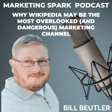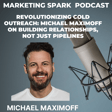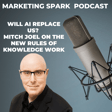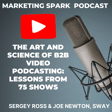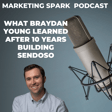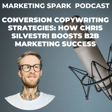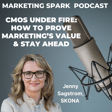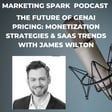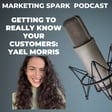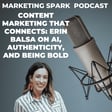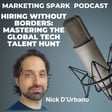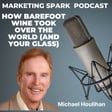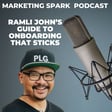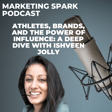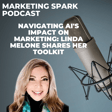Become a Creator today!Start creating today - Share your story with the world!
Start for free
00:00:00
00:00:01

From Confusion to Clarity: Billy Broas Reveals the Keys to Messaging Secrets
In this episode of the Marketing Spark podcast, Mark Evans interviews Billy Broas, a leading messaging expert.
They delve into the importance of clear, compelling messaging in marketing, discussing why it often gets overlooked in favor of more glamorous tactics.
Billy shares his insights on how effective messaging can significantly boost customer engagement and conversion rates.
He introduces his "Five Light Bulbs" framework, which helps businesses create persuasive core messaging.
They also explore the common mistakes companies make with their messaging and how to avoid them.
This episode is packed with practical advice for marketers looking to improve their messaging strategies.
Transcript
Introduction to Billy Ross and Strategic Messaging
00:00:00
Speaker
ah but Welcome to another episode of the Marketing Spark Podcast. Today, I'm excited to introduce a guest who has established himself as one of the leading messaging experts. Billy Ross helps businesses articulate their value, so prospects and customers understand what the company does, who it serves, and importantly, why and how it could matter to them. Messaging is more than just words on a page. It's the backbone of how businesses communicate their value to the world.
00:00:33
Speaker
In this conversation, Billy will help us understand why messaging is pivotal in marketing and how a strategic approach can impact customer engagement and conversion rates. Before we get into the show with Billy, something different is going to happen.
Podcast's First Advertisement: Eric Melkor's Network
00:00:47
Speaker
Since I've been doing this podcast, it has been advertising free. But a couple of months ago, I got approached by Eric Melkor. who wanted me to be part of his podcast advertising network. So here's the first advertisement running on the Marketing Spark podcast.
Lambot AI Chatbot Generator Overview
00:01:04
Speaker
In building my business, I've come to an important realization. Certain tools can be enjoyable and valuable through your prospects. I'm excited to talk about Lambot, the AI chatbot generator. With the help of AI, you can easily automate fun, friendly, and flexible conversations.
00:01:22
Speaker
Engage your leads, answer repetitive questions, or provide a round-the-clock customer service on your website, WhatsApp, Facebook Messenger, or any of your customers' favorite channels. The chatbots are super easy to design for non-technical people. I created mine in 15 minutes and could instantly deploy it on my website. If you want a hassle-free and intuitive AI chatbot that your customers will love, head to lambot.io forward slash try, or follow the link in the podcast description to sign up and create yours for free. All right, back to the show.
The Essential Role of Messaging in Business
00:01:59
Speaker
Billy, it's great to have you on the podcast. Let's get started. Hey, Mark. Thanks for having me. Yeah, I'm excited for this conversation.
00:02:07
Speaker
I always start my podcast with a softball question just to loosen things up, just to get the conversation going. So we'll ask you for your definition of messaging in the context of marketing and why it's so pivotal for businesses. I know from my experience in developing brand positioning for many companies is that It gets lumped into the nice to have category as opposed to the need to have or must have. That's a business mistake, a danger for any business that ignores the value of brand position and messaging. So perhaps take a step back and provide your high level view on the role that messaging plays and why it's so important.
Crafting Irresistible Messaging for Products
00:02:50
Speaker
Sure. And this is something we can dive more into later too, because I really learned this from studying these great copywriters throughout history. And so messaging for your prospect, your potential customer, the person you want to do a transaction with, it should make your product the only logical conclusion for them. So that's a simple answer. And I guess fundamentally that is the reason why it matters. Perhaps you could talk a little bit about why messaging is underappreciated. It should be the ball of the ball, but often it gets, if there's a dance happening, it's sitting on the sidelines, a lot of other things get more attention, and of course, budget. Do you think that companies don't recognize the value of messaging? Is it not a priority for them? Because it is, as you say,
00:03:46
Speaker
the story that they tell the world and the way that they differentiate themselves from the fierce competition out there. So provide some context in terms of the the place that positioning or that mess that messaging plays these these days. There's a lot of reasons why it doesn't get the attention that it deserves. I think one of them is just the times that we live in and there are so many shiny objects out there, things that are a lot sexier than messaging. And this was my experience too. I came from an industry Nothing up to do with marketing. I was working in the energy industry for an engineering company and then I wanted to do my own thing So I launched my own website where I was teaching beer brewing courses of all okay
00:04:26
Speaker
And cause I was really big into the beer brewing at the time, the engineering background helped a lot with that. And, and I had this formal business degree too. I had an MBA, so I was like, Oh, I can, I can definitely sell online beer brewing courses. Turns out, no, not the case at all. It was actually really hard, very difficult. I didn't learn those skills. And then in the traditional ah business school setting. I was fiddling around with the stuff that most people fiddle around with when they're trying to launch an online business. So I was dealing with websites and plugins and social media posting tools and countdown timers and all these things. And then I discovered this thing called copywriting. And I can draw a distinction in a minute here between messaging and copywriting.
00:05:05
Speaker
And what I did was I had the sales page for one of my intro to beer brewing courses, and I just rewrote the headline because I was learning about this thing called copywriting. I was like, all right, let me try to just write a better headline. And when it doubled my conversion rates, it doubled my sales. I said, why am I fiddling around with all these low, low needle moving items like WordPress plugins when I can just rewrite a headline? And so that was the big aha that I had. It makes sense when I'm looking back on it, that if you change your words, you change your results. It really is the biggest needle mover that you have. As someone who spent a lot of time playing with words and using words professionally, I love it when someone actually puts the value of words into the spotlight. One of the things that I run into in working with clients is that a lot of marketing
00:05:58
Speaker
They like strategy. They like talking about strategy. Strategies are very sexy. But what really matters to them is outcomes. In my world, in your world, it's conversions, leads, sales, and MQLs, SQLs, the metrics that seem to matter. It would be great if you could provide some insight or direction into the correlation between better messaging and how and the outcomes for the business. for any CEO who maybe doesn't appreciate the the value of messaging, it would be great for you to enlighten them or educate them on the fact that if you have better messaging, more effective messaging that aligns with what your target audiences are seeking, then there is a positive impact on the business and maybe you can define what that impact may be. And it can be many things, I suspect.
00:06:52
Speaker
So what I realized about messaging and so I went down this rabbit hole of copywriting studying these great copywriters. And what I discovered is that a lot of people think copywriting is about writing clickbait headlines and and and stylistic improvements, like using subheads and bullet points and all those things. But and I know you have a ah journalism background too, so this will resonate. Now I discovered that copywriting is really the art of argumentation. This goes back to thousands of years to Aristotle. And so what I realized was that marketing is really making an argument and not like a heated argument, like a road rage, an argument, but making a rhetorical argument where you're making claims and assertions and backing them up with proof. And the reason why that's important, how that leads to these outcomes, these metrics like ah ROI and click through rates and all these things is if you don't have buy-in from your prospects on these assumptions that you were making, then you're just going to hit a brick wall when you go to make them an offer.
00:07:50
Speaker
So what I found was I became the behind this after my beer website, I became the behind the scenes marketing guy working with these these other like very smart people who had mainly in the online course and coaching field, tech software, harder to understand products. These are very smart people, right? So the curse of knowledge. So they had all these assumptions when they turned around to from the, they turned from the product to the marketing side and made all these assumptions, things that they assume that the prospect knew that just wasn't, weren't the case. So I came in and said, Hey, look, no, we need to make an argument for these things that you're assuming because you're throwing all these coupons and discounts at them. And they're just bouncing off a brick wall. But once we made our argument and we got buy-in, then they were open to the more traditional,
00:08:33
Speaker
what we call sales technique, copywriting techniques, like the the upsells, downsells and such. And then that's when we saw these big improvements in those metrics like conversion rates. Yes. And also too, you just get a better quality customer when you're a real or client, when you're relying on more sales tactics, things like discounting, things like bundling and all that. You don't get nearly the quality of customer or client that you get if you first established this mutual understanding through your argument and they're on board with your methodology and then you make them the offer. So it's also ah the difference between short-term and long-term thinking. I spend a lot of time, probably too much time thinking about the triggers that make companies explore and buy marketing services.
00:09:21
Speaker
In many cases, there's a pain or a problem that they need to solve, something that is front and center. So obvious, for example, is a website that's not converting. It looks bad. The navigation's awful. The head of marketing, the CEO can see that every day. It's in front of them. When it's things like messaging, the problems that a company suffers from may not be front and center or so overt. It may not be a pain that you feel like you look at your, you can feel it like, and it stings and it hurts and it's right in front of you. Two full question here. One is, what are the signs that your messaging isn't working? What are the the triggers that would make you say, we've got to do something about our messaging because
00:10:09
Speaker
it's holding back the business. And then the second step would be once you recognize that, where do you start? What are the first steps that you should take to make sure that you're on the right road to creating better, more effective messaging? Good questions. I always like to talk to prospects and customers. in doing that and and you really have to listen and they will talk. People love to talk. Just ask, start asking them the questions. Don't try to pitch a product or shove it in there or anything. Ask about how they normally go about solving the problem that you solve and you will surface all sorts of assumptions that you've been making. Like they'll be saying things and you'll want to jump in and say, Oh gosh, why are you doing it that way? Or no, don't you know, that's a terrible way. And that's when you have a messaging problem because your prospect is not fully educated.
00:10:56
Speaker
If they were what you need to do through your, through education based marketing material, this is the job of your marketing material. This is the job of your website and your social media content and all of that. Then when you speak with them, they would be on the same page as you and believe all the same things that you believe. And you could have a better conversation about your offering and if it's the right fit for them and pricing and such. That's a great way to do it. If you're not doing it, that's the best way. If you're not doing it on calls, look for things like low engagement with your email marketing. for things like offering those discounts, but not getting the sales that you thought you might get. You say, oh my gosh, we're discounting this 20% and they're still not buying. So if you're facing that kind of a resistance, people are confused by what you're offering, then it's likely a messaging problem.
00:11:41
Speaker
But it sounds like no one comes to you and says, Billy, you got to help us. We have a messaging problem. It's obvious to us that this is what we're suffering from. They come to you and say, we got an email marketing problem. We've got a website conversion problem or a content marketing problem, or there's some other problem. So in a sense, are you like a detective? who listens to people that have suffered some kind of marketing crime, your job is to say to them, listen, from what I can tell, from the story that you're telling me,
00:12:13
Speaker
It's not that your website is badly designed, really bad messaging. Are you the one that's actually telling them that they have a messaging problem? Or do you have clients that come to you cognizant of the of the fact that messaging is their problem? Or is it a combination of both? It's a combination. I certainly get people who come to me knowing they have a messaging problem. They tend to say things like our messaging is really unclear. Prospects just aren't getting it. Even we don't quite understand what our value proposition is. Often there's multiple benefits and they're not ah that the product offers and they're not sure which ones to highlight. Other scenarios would be they're coming out with a new or an updated product. Our customers have to go through marketing assets to experience our product or service, right? So things like sales pages, emails, websites. So since they know that I'm the messaging guy, they're like, Hey Billy, can you help us
00:13:02
Speaker
create these things and we'll create the core messaging and then we distribute that through the copywriting. That's that distinction into these marketing assets. Let me ask you a bit of a tangential question. As somebody who's spent so much time on messaging and helping companies optimize and can improve their messaging, so it converts. How hard is it for you to resist reaching out to companies when you know they're high profile, they're doing well, and you hit their homepage, and the messaging is confusing and unclear and undifferentiated? You know.
00:13:36
Speaker
that they could do even better if they had better messaging. now I see it all the time. It's obvious to me that somebody hasn't done their job properly. Do you feel the temptation to do that and do follow through? I've gotten good clients that way, especially when I point out because we were so close to it. We have this curse of knowledge. So when someone comes in with a fresh perspective, it's like you throw a bucket of cold water on them and they're like, Oh my gosh. And especially when I bring up this topic that I brought up with you about making your argument, I'll go through and say, Hey, look, you're just assuming that I know what this is. I don't know what this is. You're assuming that I believe that this thing is important. I don't believe that this is important. So I go through it, like playing devil's advocate and being their biggest skeptic. And then, Oh, okay. I think we need to to revisit this thing here. I do want to talk to you about your five light bulbs framework. But before we get into it, once a company recognizes they have a messaging problem,
00:14:31
Speaker
and they're willing to do something about it, willing to make an investment in it. What are the first steps? And you can meld this into your framework if that's the way you want to go, but I'm really interested in companies recognizing that, okay, we got to do something different. We need some help to tell a different story. So where do they start? How do they start? What's the, what does that process or framework look like? I'll bridge us into the five light bulbs because this was really created as a solution to that problem because I was working behind the scenes of these entrepreneurs and saw that they were spending so much time with these tactics and these shiny objects and even doing copywriting. And again, the the distinction I'll make there is
00:15:11
Speaker
messaging is upstream of your copywriting. So copywriting, and if people don't know what copywriting is, it's essentially salesmanship in print. So imagine that you have a team of salespeople. That's great. That really is the best way to sell if you can have a one-on-one conversation with someone. But when you want to scale, it becomes It needs to become one to many. So you essentially take what the salesperson was saying and you put that into words. And you can, it used to be printing, right? You'd you'd send direct mail to 10,000 people. And now you can do it through your website or through Facebook ads or through emails. And so you want to think about each word that you put out there as a little salesperson that's going out there to do your bidding and to bring you back customers. And together all those words form this, the sales army.
00:15:55
Speaker
But it needs to all stem from your core messaging. And I described that as it's like a brand manual, brand manual is how they define your fonts and your logos and colors and all that. I said, why don't we have the same thing but for our persuasive messaging. And I can talk more about what that should do to the five light bulbs. So I was working on this campaign. It's mainly doing product launches, right? So new product development. Okay. We need a whole campaign. We need email, social media posts, websites, the whole thing, but it's got to all be aligned. We got to tell the same story and we got to make the same argument, which is really important. So rather than starting downstream by jumping in and like doing an email here, social media posts here.
00:16:33
Speaker
Let's create this core messaging first, similar to a brand manual. And then we can distribute it downstream to all these marketing assets that we're going to use. And that way they're aligned and they're persuasive. So does that make sense? And then if so, I can bridge into the five light bulbs. And that makes sense. This is a good opportunity to talk about the five light bulb. You've got a process. You've got a methodology. Walk me through that methodology from client comes in. Yes, we've got a messaging problem to Billy saying, okay. We're gonna use this framework. It's gonna get us to where we need to go. Here's how the journey's gonna unfold. We start with this idea of this one-to-many relationship where you have your core messaging and then you distribute it to your marketing assets. And this is not totally novel. There's not a ton of these messaging frameworks out there. Probably the best well-known one is Storybrand if you're familiar with Donald Miller. Yeah, with Donald Miller, of course. He takes the same approach. You first create your Storybrand. I believe he calls it a StoryScript. And then you can apply it to your sales funnels, website, et cetera. It's like my Storybrand.
00:17:31
Speaker
And and i i discovered it it was freaky how i discovered it i was preparing for a program i was running and i was doing the curriculum when i was drawing this framework that i had before in these light bulbs and i was very mad about the light bulb went on in my head and i drew these five light bulbs over this bridge connecting one side of the bridge to the other and that's the path that your customer takes. And so what these are, the file light poles are categories of messaging. So these are things that you want to say to give voice to in your marketing material to like that path to your product.
00:18:02
Speaker
And although they're very simple, there's a lot of depth to this as well. Like I said, I've studied copywriting a lot and I baked a lot of advanced copywriting techniques into the framework. So it's perfect for people who don't want to become professional copywriters, but still want a lot of those benefits of strong copy. So light bulb one. So this is that left-hand side of the bridge. This is where the customer has a problem and light bulb one represents their status quo. So again, this is where they have a problem and this is where they want to get, this is an area they want to get away from. It's their status quo. It stinks. It's no good. And things can get worse if they don't do anything. And so one is really the language of empathy. So you think about a lot of websites and and what do you see all over these websites? It's all about the company or the person, right? It's just we, I, we've won all these awards. We're the best.
00:18:50
Speaker
And any copywriter will tell you that the word you want to have is the word you, my OU. That's the most powerful word in marketing, but it's easy to forget that. and And it's not that we have like big egos, maybe some people do, but we, like people I work with, they want to jump into solution mode right of away. Like they want us to say, I can solve your problem. I, anyone who has ah a spouse will relate to this. And when your spouse comes home and and they've had a rough day, do they want you to jump right in and solve their problem? No, i like they just want to be seen. They want to be heard. Like my wife, like sometimes the best thing I can say when she has a day like that is, honey, that sucks. And she's, yeah, it does suck. Thank you for understanding me being the consultant though. I want to be like, have you tried this? And so like, why should it be any different with our customers then?
00:19:34
Speaker
So that's light bulb one. And this is, and look, I'm going to write one day, the five light bulbs book for relationships for couples, because this is such a valuable tool to have with a spouse or a partner. And so it's a way to check that box and say, okay, I checked light bulb one. I'm acknowledging you customer. Okay. So then they they feel seen and heard right. They're like, okay, well this person really gets me. and and And you know how it is. If, if someone can describe your problem even better than you can, you're going to naturally assume that they have a problem too. So we have prospect listening now. but are we the only option for them? Are we the only game in town? Absolutely not, right?
00:20:09
Speaker
and And so what you don't want to do is just ignore all those other options. And in fact, the opposite, you want to give voice to them. And so that's represented by light bulb two, which represent the other options your customer has tried, or they're being tempted by. Right. And this is where that argumentation piece comes into place. What you don't want to do is just say, Oh, don't go with them. They stink or they're stupid, or we're the best, right? Treat your customer, your prospect as if they're intelligent. And that's just not a strong argument you're making when you just bad mouth the competition. lay out the criteria by which they should make their buying decision. And you know what, in some cases, those those other options, those other bridges are the best option for your customer. And if you're doing this, honestly, there should be times where you say, you know what, I'm not the best fit for you, or at least not right now, but I know this guy, Mark, and he is perfect for you. Let me make an introduction. and That makes sense. I think haplasia, who's a well-known messaging, talks about the fact that in many cases,
00:21:07
Speaker
it comes down to three choices. Whatever product you're looking for, you have three options despite the fact that there are dozens if not hundreds of competition. I can understand why you wouldn't want to bash the competition because they're just as good as you are in many respects. You may be different and you have to position yourself as the obvious option, but the fact that you should respect your competition as opposed to denigrate them is, makes a lot of sense. We're two for five into the process. Then you make the argument, why those options are not the best. And what you should do is your prospects should come to the logical conclusion that your option is the best, but we still need to do that. We do that by giving voice to your light bulb three, which represents your unique approach. So this isn't your product. Your product is just a vehicle for your approach. Spoiler alert, your product has light bulb four.
00:21:52
Speaker
Lightbulb 3 represents your methodology, your blueprint. It's it was really interesting. This is a warning to your listeners that and once you see these lightbulbs, you can't unsee them. We can even market. There's a place where you can put links. I can put a link to a, I created a swipe file, which is a collection of advertisements that you like. I created one of those that, and the light bulbs, and I label them with all the light bulbs and the light bulbs are just popping out of these advertisements. We got Facebook ads, emails, headlines. And, and so light bulb three is shows up in all these different product categories. So in the, let's see, like in the clothing space, I think about under armor and their moisture wicking technology, like that technology is not their product. That's their light bulb three, their approach, their secret ingredient and the consulting space. It's going to be your methodology in a software space might be your methodology might be your technology might be the software that you use.
00:22:45
Speaker
And so what what we discovered was that when you better sell your light bulb three, better get buy-in on that approach, you much more easily sell your light bulb four, which is your product.
00:22:59
Speaker
And then with light bulb five. And then Lipo 5, yeah, so again, Lipo 4 is your product. it's It's also the things that go with your product. We call it your offer, so it's any incentives that you have, like bonuses or risk reduction. And so assuming they they buy into your Lipo 3, your approach, they buy your product, your Lipo 4, then they reach that other side of the bridge, which is your Lipo 5, and that is where they have success with your product. That is where the the birds are chirping. The sun is shining. I have a bunch of visuals on this, by the way, that's why I'm using terms like bridges and things. So if you go to flybypost.com, you'll you'll see the whole framework there. I had an excellent illustrator create illustrations for it. But for lipo five, you still want to give voice to your lipo five. And this is a big thing that people I work with struggle with because they're so close to their product that they have this assumption that Oh,
00:23:45
Speaker
The customer will just, they'll just get it. They'll just, they'll just know what it can do for them. It's like, you want to check that box in your lipo five and tell them why your technology or your product, whatever it is will help them solve the problem. In your experience, what are some of the common mistakes companies make with their messaging and how can these be avoided? Maybe you can tie a some of your clients into this question. Not every client is a super successful engagement. Some buy into it, some reject your messaging because it doesn't align with their values. What are the things that
00:24:23
Speaker
make a messaging exercise fall down flat. That doesn't work. What are the mistakes that companies will make because they're not ready for it. They just don't believe it it. Something doesn't click for them. Misalignment is one, especially if there's a team. So just mis misalignment, mis miscommunication on what the five light bulbs are for their prospect. So I was working with, I've done some work with YC companies, Y Combinator tech companies. And and it's incredible when they get around what we do. We, ah like I said, we take this core messaging approach, the way that materializes with the five light bulbs is we create something called a messaging map.
00:25:01
Speaker
It's usually a Kanban, like a Notion board or a Trello board or something. Five columns, one for each light bulb. but And man, I just need to pull that thing up with the team on the call too, and just get them started. And then just sit back and watch. And the discussions that take place, ah that's not our light bulb one. This is our light bulb one. No, I don't think that's our light bulb three. I think this is our light bulb three. And then they realize like, why are we doing anything else when we haven't sorted this out yet? This is so key. This is so fundamental. If we don't even know the value that we provide, if we don't even know our light bulbs, why are we messing around building all these websites and we are paying this expensive agency to run social media ads for us? It doesn't make any sense. So getting the team around and I like to use the five light bulbs. You can use another framework if you want, but just having those conversations where you ask these questions, like what is the problem they're dealing with? What is our unique solution? What are the other options they have? ah That alone does a lot of good.
00:25:57
Speaker
But isn't that interesting because when I do brand positioning work, yeah I go into it assuming that everybody's on the same page. This is a 24 seven drink the Kool-Aid kind of exercise. They're all rallying behind the same vision mission, the raison d'etre for the product. It's just a matter of crafting a narrative that reflects where they want to go, what the product doesn't, where they want to go. When you get into it, the VP of sales. is telling a different story than the head of marketing then the CEO and you recognize that. Are these people talking to each other i know the remote work has made collaboration even more challenging but you would think. Something as fundamental as position messaging that they don't be reading off the same script when someone came to them and said listen let me help you with that that it would be a fairly seamless process because.
00:26:53
Speaker
we all believe the same things. Why does misalignment happen? I know that from working in a startup, when you're in the ah either hurricane, it's easy to be focused on your own little part of the operation. From your experience, why does misalignment happen and and how do you fix it? It's one of those things like it's easy for me to come in because this is my world and it's so obvious to me. I've also been the entrepreneur myself, right when I was running that beer brewing website. and and And so I have empathy for them and they just, they wear a lot of hats and there's so many different things competing for their attention. Things move quickly, especially if you're talking about a company like a startup where even the product is changing so quickly. Every time that product changes, you need a new messaging map, right? So it's, so when you're moving fast and breaking things, it's it's very difficult to stay aligned.
00:27:39
Speaker
And then I would also say just all those, like I said earlier, all those shiny objects out there, everyone wanting to sell them their new tool, their new AI plugin, whatever it is. So it's very easy for something as timeless and old school and fundamental as messaging and argumentation to be drowned out by all these loud voices.
00:28:00
Speaker
It's interesting that you mentioned AI because the next question I was going to ask you was around the process of redefining and evolving your messaging over time. How do you know when it's. time to adjust your approach. It is interesting to see so many companies, so many technology companies have messaging that says AI powered, leverage AI. It's the flavor of the day and they all feel like it needs to be front and center. It goes probably back to maybe it's it's around light bulb four, which is AI is your, an inherent part of your product, but it's not what makes you different. It's not light bulb three, which is your approach or your differentiator.
00:28:40
Speaker
I think a lot of tech companies fall into the trap of following that shiny, sexy object. If we're not rallying around this thing, then prospects are gonna think that we're not as innovative or as interesting or as differentiated. And how do you battle that from your perspective? How do you convince clients that there is this shiny object, but we don't have to chase it? In fact, what we can do is we can focus on our own strengths and our own story. And that'll, in the long term, that'll get us where we need to go.
00:29:11
Speaker
the The best way I've found ah is to let them prove it to themselves. For example, I run programs like group-based programs where we create these messaging maps, do the five lipos for clients. And I tell them it it's not about just sitting back and learning. Send this email today, send a lipo three email today and you will see. And so it's this idea of like these these assumptions that I've been telling them that they're making. Don't listen to me, just try this, give voice to some of these light bulbs and do it. And without fail, we get these people coming back into our group and saying, oh my gosh, we just doubled our sales and we just got this huge, biggest response I ever got. Yeah, because you assumed something that wasn't true. And once you take a step back and start addressing these things that to you are just so basic, you're you're going to open the floodgates because it might just be one false belief that your prospect had.
00:29:54
Speaker
that was preventing them from accepting everything else that you're talking about. So that's the best way is I just to put this into action and you will see the results. It's fascinating when not to steal your thunder or anything, but when the light bulb goes on for many clients, I was working with a condo software company and working with the CEO and the CRO and we were probably about three quarters of the way through the positioning exercise. It was pretty obvious what the new story was. And the sales, the head of sales was so excited that he went off to a conference and started telling the new story to see how it resonated. And it resonated better than any of the stories that they had told before. now
00:30:35
Speaker
Obviously, I like to think that was because of my brilliant work, but I think it was because they heard a different voice. It was a story that they hadn't considered before. The only way to find out if something works is to try it in the real world. Do some experiments. And if your prospects ask you questions that mean that they get it or they're interested or they're curious, then you're on the right path. If they're confused, then your messaging isn't working. Are there ways that you can test messaging other than sending an email or having a conversation at a conference, some of the the techniques that you advise your clients? I love that example to give you another one too. And you're going to see this work the best and in spaces that are are fairly commoditized. I was working in this for an Excel business. So Excel training, pretty successful online education company. And then the founder went through one of my programs and she went through back through one of their, like their most popular sales pages for their most popular course, made an update incorporating.
00:31:23
Speaker
these ideas, these light bulbs, and Excel, right? So she tracks things very closely, added $7,000 per week to the sales that they were already getting from that page. So like a crazy amount just from addressing something, an objection, it's essentially an objection that their prospects had that we brought light to with Sorry, all the metaphors. what's a five but It it needs to rubber mis needs to meet the road somewhere, right? Your messaging needs to bump into your prospect somewhere. So whether it's through a customer interview or whether it's through an email or a website, it needs to make contact somewhere. So that's really the best way to test this stuff. So here's the $64,000 question. It comes back to my original premise about CEOs and entrepreneurs and executives looking for outcomes.
00:32:07
Speaker
How do you measure quantify the effectiveness of measuring? So you go through the five love balls process. There's a lot of learning and a lot of enlightening that goes on. I'm sure as people lean into their product and their customers, but at the end of the day, how do people quantify how well Billy Ross has performed for them? What are some of the the signals or the metrics that they can focus on and say, that was a really successful, amazing engagement that moved our business forward? Is there things that that are like front and center or is it more subtle, more nuanced or does it appear
00:32:48
Speaker
Does the impact happen in places like better website conversions or email open rates and things like that? Good question for the Excel teacher. It was more qualitative. It was more nuanced because although we hit on all the light bulbs, a big thing for her was standing out in this very crowded industry of Excel training where you got all these Excel training websites and they all sound the exact same. Right. Learn Excel, learn VBA, learn Power BI and all these things. so For her was the light bulb three. And we identified these three pillars that really made her stand out from everyone else. And it was things that she truly believed in. Like she has a way that she approaches Excel. And so although like we increased her revenue a lot, I went on to work with her one-on-one after that program.
00:33:27
Speaker
The thing, if you were to ask her the thing that was the biggest benefit, it was really identifying that light bulb three, because she stands out now, she doesn't sound like everyone else. Now, when she goes and gives talks or goes on her YouTube channel, she can always come back to these three pillars, which ah ah people like a lot for another reason too. It's because, and they always tell me this, they say, now I don't have to just talk about my product or my light bulb four. they They tend to get stuck in this life before silo which is all about the offer and the pricing and all that it gives them something else to talk about their life of three which is not directly product related but funny enough sells the product even better than directly talking about the product. That is an interesting story because how someone feels about the engagement and the outcomes. Some in some ways flies in the face of what many
00:34:20
Speaker
executives are looking for, which is more leads, more sales, higher brand awareness. I think it takes away from the value of messaging. It doesn't reflect that messaging can be subtle and the impact can be more nuanced and be a slow burn rather than a flaming fire, otherwise known as leads pouring in the door. Your impacts are overflowing. Is that, was the Excel executive kind of an exception to the rule or would she fall into the minority camp? As part of your process getting people to buy into the idea that this is, there's something more sophisticated
Long-term Success in Messaging: Client Story
00:35:00
Speaker
about this. I don't know if that's the right word than simply more leads.
00:35:06
Speaker
I've found that it's not that black and white where people, my clients just want more money, more leads. I remember one, like one very successful client and he's like, man, I do not care about revenue. I want longevity. Like I know I can make a lot of money really fast. I have a big email list. We can send them promotion after promotion right now, but I also know that I'm going to burn them out and burn out my reputation. And I was like, okay, this is different than my usual client, but okay, awesome. I love this. Let's take the long-term approach. And so many competitors have come and gone who have made good short-term cash. And now he's, he's a very big name and he's talking to very high level people and just crushing it. And yeah, the revenue is there. So I think it depends on who it is. I think we'd rather have clients like that. But look, it depends on the industry. The five light bulbs is being used by a lot of agencies now, marketing agencies who are doing marketing for other clients.
00:35:51
Speaker
And they are definitely metric driven for them. It's something more, Hey, we tested five different ads, one for each light bulb. And this one tripled the conversion rates. That's what they're looking for.
Conclusion and Contact Information
00:36:04
Speaker
Great conversation. Love talking about messaging. Love the idea of strategic narratives and and the power of words. Where can people learn more about you and the five light bulbs framework? So the framework five light bulbs dot.com. I also have a book that will probably be out by the time this areas because it's launching on June 7th. It's called simple marketing for smart people. It's really the underlying philosophy behind the five light bulbs goes a lot into surfacing these assumptions that smart people, that's why I titled it the way I did make about their prospects and how to overcome.
00:36:38
Speaker
those objections that your prospects have. So simple marketing for smart people. Also send a weekly newsletter at billybross, b-r-o-a-s dot com. You can find that. Thanks Billy, and thanks to everyone for listening to another episode of Marketing Spark. If you enjoyed the conversation, rate it, subscribe via Apple Podcasts, Spotify, or your favorite podcast app and share via social media. And if you're a B2B SaaS company with revenue between one and $10 million, dollars looking for strategic and tactical support to scale, we should talk about how I can help you do marketing that drives outcomes, whether you're looking for lead sales, brand awareness, or simply looking to get key projects completed. Reach out to me via email, mark at markevans.ca. Connect with me on LinkedIn or visit MarketingSpark.com. Talk to you later.
00:37:28
Speaker
are
00:37:36
Speaker
i the

